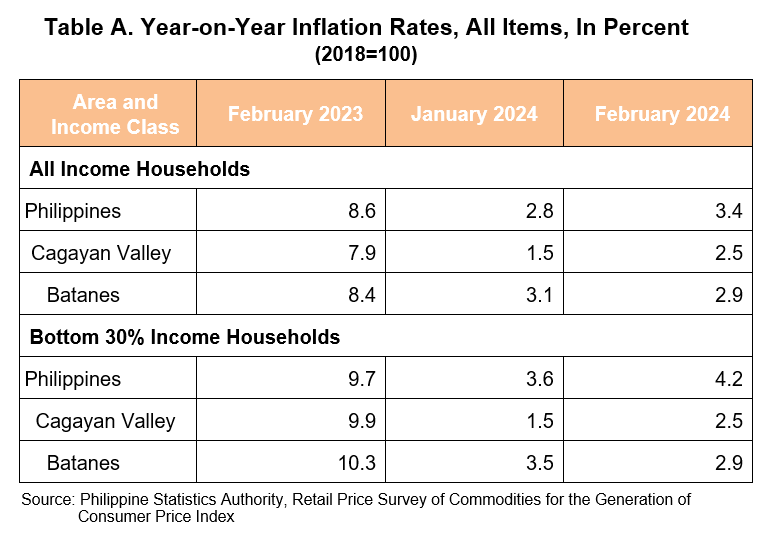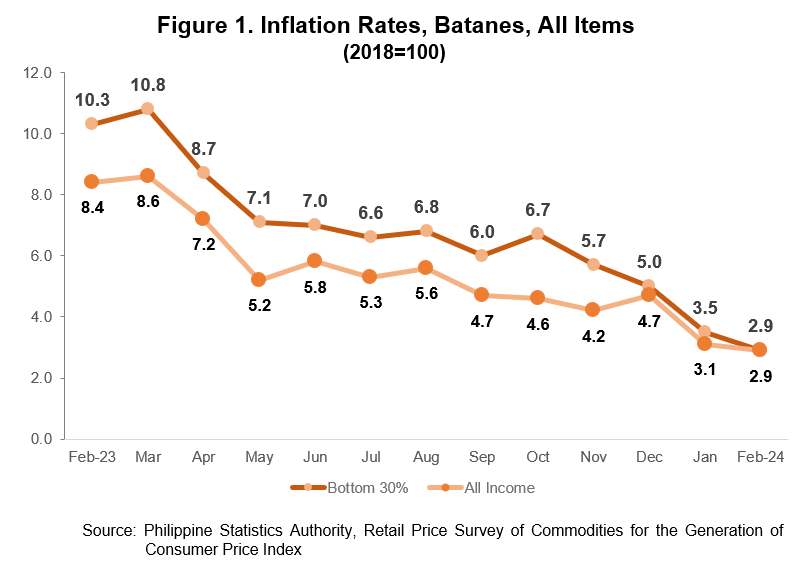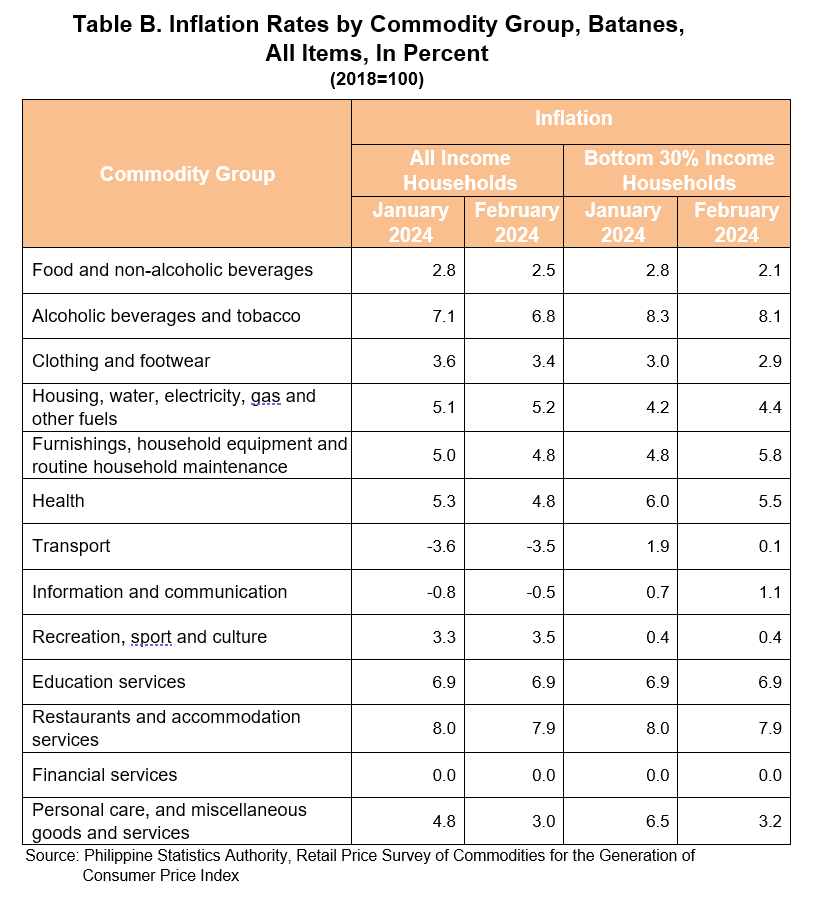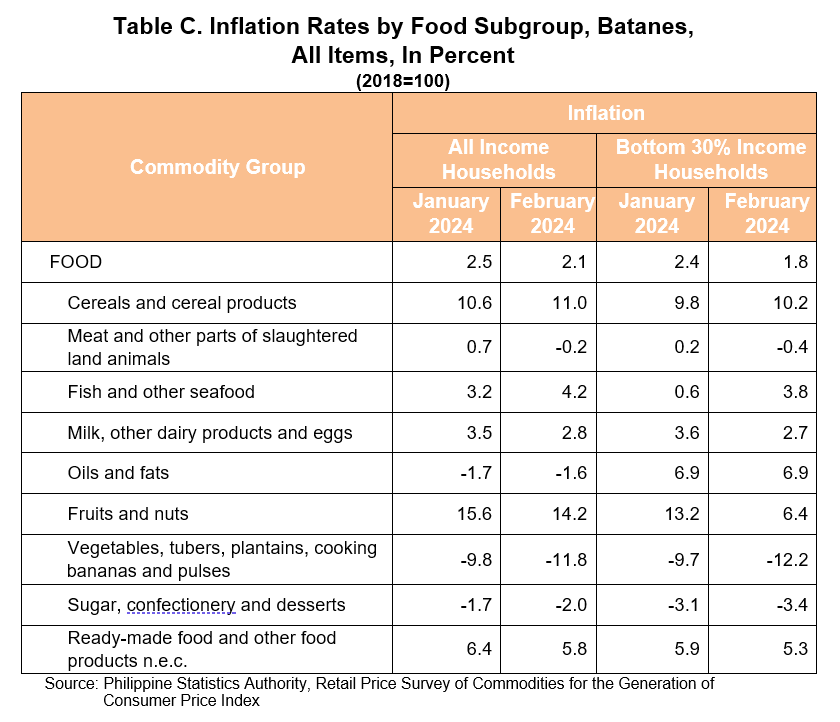
The inflation rate for all income households in the province of Batanes slowed down further in February 2024 at 2.9 percent from 3.1 percent in January 2024. Meanwhile, inflation in the province in February 2023 is relatively higher by 5.5 percentage points at 8.4 percent. In the region, inflation in Cagayan Valley accelerated to 2.5 percent in February 2024 from 1.5 percent in January 2024. Nationwide, the inflation also exhibited an uptick at 3.4 percent during the reference period from 2.8 percent in the previous month.
The inflation rate for all income households in the province of Batanes slowed down further in February 2024 at 2.9 percent from 3.1 percent in January 2024. Meanwhile, inflation in the province in February 2023 is relatively higher by 5.5 percentage points at 8.4 percent. In the region, inflation in Cagayan Valley accelerated to 2.5 percent in February 2024 from 1.5 percent in January 2024. Nationwide, the inflation also exhibited an uptick at 3.4 percent during the reference period from 2.8 percent in the previous month. (Table A and Figure 1).
In addition, the inflation for the bottom 30 percent income households, or the household whose per capita income falls below the bottom 30 percent of the cumulative per capita distribution, remained at the same rate with the inflation for all income households in the province and the region during the second month of the year at 2.9 percent and 2.5 percent, respectively (Table A). Although remained at the same rate, it can be seen from Figure 1 that the inflation for the bottom 30 percent income household in the province is generally higher for the past 12 months. In comparison, the national inflation for the low-income group increased from 3.6 percent in January 2024 to 4.2 percent in February 2024 (Table A).

The major driver of the trend in the province’s inflation for all income households was the lower year-on-year change in the index of the heavily weighted food and non-alcoholic beverages which declined from 2.8 percent in January 2024 to 2.5 percent in February 2024. This was followed by the lower inflation of personal care, and miscellaneous goods and services which slowed down from 4.8 percent in the previous month to 3.0 percent during the reference month. Other commodities which contributed to the downtrend of this month’s inflation are the following:
a. Alcoholic beverages and tobacco, 6.8 percent;
b. Clothing and footwear, 3.4 percent;
c. Furnishings, household equipment and routine household maintenance, 4.8 percent;
d. Health, 4.8 percent; and
e. Restaurants and accommodation services, 7.9 percent.

In contrast, housing, water, electricity, gas and other fuels (5.2%), transport (-3.5%), information and communication (-0.5%), and recreation, sport and culture (3.5%) exhibited a faster growth on the year-on-year change in their indices during the reference period. In addition, education services maintained its previous month’s inflation at 6.9 percent while financial services remained at zero percent annual rate. (Table B)
For the bottom 30 percent income households, the deceleration of inflation was due to the slower growth of food and non-alcoholic beverages (2.1%) followed by personal care, and miscellaneous goods and services (3.2%) and transport (0.1%). (Table B)
Inflation for food for all income households further moved at a slower rate at 2.1 percent during the reference month from 2.5 percent in the previous month. Food inflation for the low-income group is relatively lower at 1.8 percent in February 2024 than 2.4 percent in January 2024. (Table C).

The main drivers of the lower inflation for food for all income households are the deflation in the food groups: vegetables, tubers, plantains, cooking bananas and pulses (-11.8%); and meat and other parts of slaughtered land animals (-0.2%); and the deceleration of the year-on-year change in the index of fruits and nuts (14.2%).
For the bottom 30 percent households, the main driver was the lower inflation in fruits and nuts (6.4%). This was followed by the deflation in vegetables, tubers, plantains, cooking bananas and pulses (-12.2%) and meat and other parts of slaughtered land animals (-0.4%).
Note:
CPIs and inflation rates by province and selected city are posted at the PSA website (https://www.psa.gov.ph/).
RAMIL G. ABAD
Chief Statistical Specialist
PSA-Batanes
